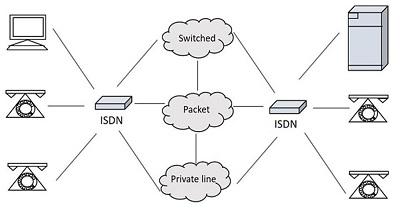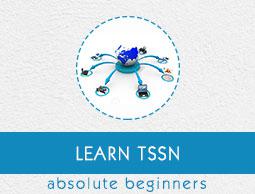TSSN - ISDN
In this chapter, we will learn about the Integrated Services Digital Network. Earlier, the transmission of data and voice both were possible through normal POTS, Plain Old Telephone Systems. With the introduction of Internet came the advancement in telecommunication too. Yet, the sending and receiving of data along with voice was not an easy task. One could use either the Internet or the Telephone. The invention of ISDN helped mitigate this problem.
The process of connecting a home computer to the Internet Service Provider used to take a lot of effort. The usage of the modulator-demodulator unit, simply called the MODEM was the essential thing to establish a connection. The following figure shows how the model worked in the past.

The above figure shows that the digital signals have to be converted into analog and analog signals to digital using modem during the whole path. What if the digital information at one end reaches to the other end in the same mode, without all these connections? It is this basic idea that lead to the development of ISDN.
As the system has to use the telephone cable through the telephone exchange for using the Internet, the usage of telephone for voice calls was not permitted. The introduction of ISDN has resolved this problem allowing the transmission of both voice and data simultaneously. This has many advanced features over the traditional PSTN, Public Switched Telephone Network.
ISDN
ISDN was first defined in the CCITT red book in 1988.The Integrated Services of Digital Networking, in short ISDN is a telephone network based infrastructure that allows the transmission of voice and data simultaneously at a high speed with greater efficiency. This is a circuit switched telephone network system, which also provides access to Packet switched networks.
The model of a practical ISDN is as shown below.

ISDN supports a variety of services. A few of them are listed below −
- Voice calls
- Facsimile
- Videotext
- Teletext
- Electronic Mail
- Database access
- Data transmission and voice
- Connection to internet
- Electronic Fund transfer
- Image and graphics exchange
- Document storage and transfer
- Audio and Video Conferencing
- Automatic alarm services to fire stations, police, medical etc.
Types of ISDN
Among the types of several interfaces present, some of them contains channels such as the B-Channels or Bearer Channels that are used to transmit voice and data simultaneously; the D- Channels or Delta Channels that are used for signaling purpose to set up communication.
The ISDN has several kinds of access interfaces such as −
- Basic Rate Interface (BRI)
- Primary Rate Interface (PRI)
- Narrowband ISDN
- Broadband ISDN
Basic Rate Interface (BRI)
The Basic Rate Interface or Basic Rate Access, simply called the ISDN BRI Connection uses the existing telephone infrastructure. The BRI configuration provides two data or bearer channels at 64 Kbits/sec speed and one control or delta channel at 16 Kbits/sec. This is a standard rate.
The ISDN BRI interface is commonly used by smaller organizations or home users or within a local group, limiting a smaller area.
Primary Rate Interface (PRI)
The Primary Rate Interface or Primary Rate Access, simply called the ISDN PRI connection is used by enterprises and offices. The PRI configuration is based on T-carrier or T1 in the US, Canada and Japan countries consisting of 23 data or bearer channels and one control or delta channel, with 64kbps speed for a bandwidth of 1.544 M bits/sec. The PRI configuration is based on E-carrier or E1 in Europe, Australia and few Asian countries consisting of 30 data or bearer channels and two-control or delta channel with 64kbps speed for a bandwidth of 2.048 M bits/sec.
The ISDN BRI interface is used by larger organizations or enterprises and for Internet Service Providers.
Narrowband ISDN
The Narrowband Integrated Services Digital Network is called the N-ISDN. This can be understood as a telecommunication that carries voice information in a narrow band of frequencies. This is actually an attempt to digitize the analog voice information. This uses 64kbps circuit switching.
The narrowband ISDN is implemented to carry voice data, which uses lesser bandwidth, on a limited number of frequencies.
Broadband ISDN
The Broadband Integrated Services Digital Network is called the B-ISDN. This integrates the digital networking services and provides digital transmission over ordinary telephone wires, as well as over other media. The CCITT defined it as, “Qualifying a service or system requiring transmission channels capable of supporting rates greater than primary rates.”
The broadband ISDN speed is around 2 MBPS to 1 GBPS and the transmission is related to ATM, i.e., Asynchronous Transfer Mode. The broadband ISDN communication is usually made using the fiber optic cables.
As the speed is greater than 1.544 Mbps, the communications based on this are called Broadband Communications. The broadband services provide a continuous flow of information, which is distributed from a central source to an unlimited number of authorized receivers connected to the network. Though a user can access this flow of information, he cannot control it.
Advantages of ISDN
ISDN is a telephone network based infrastructure, which enables the transmission of both voice and data simultaneously. There are many advantages of ISDN such as −
- As the services are digital, there is less chance for errors.
- The connection is faster.
- The bandwidth is higher.
- Voice, data and video − all of these can be sent over a single ISDN line.
Disadvantages of ISDN
The disadvantage of ISDN is that it requires specialized digital services and is costlier.
However, the advent of ISDN has brought great advancement in communications. Multiple transmissions with greater speed are being achieved with higher levels of accuracy.




